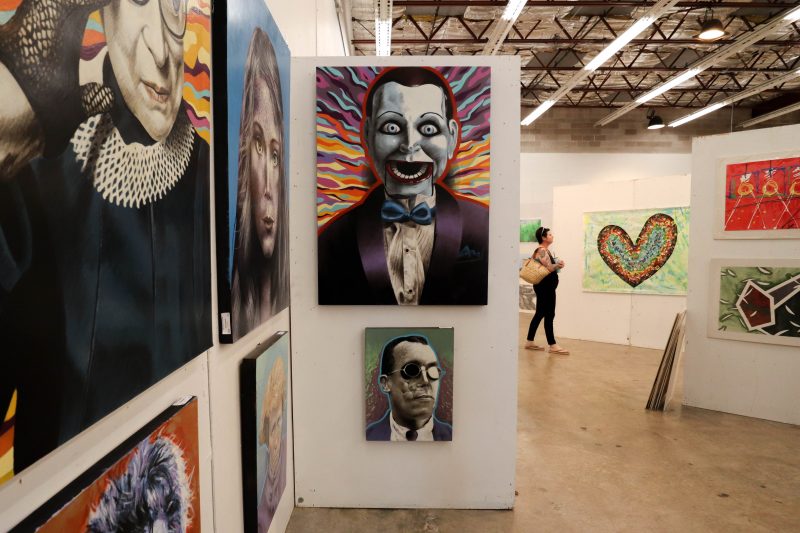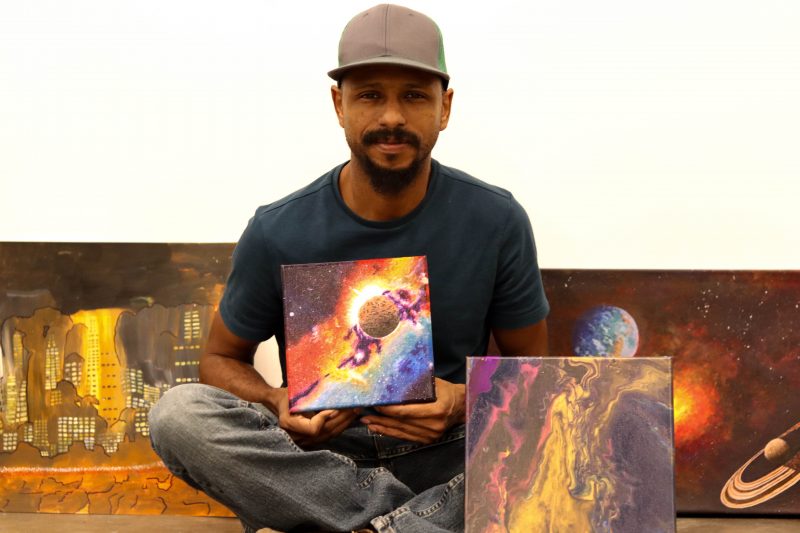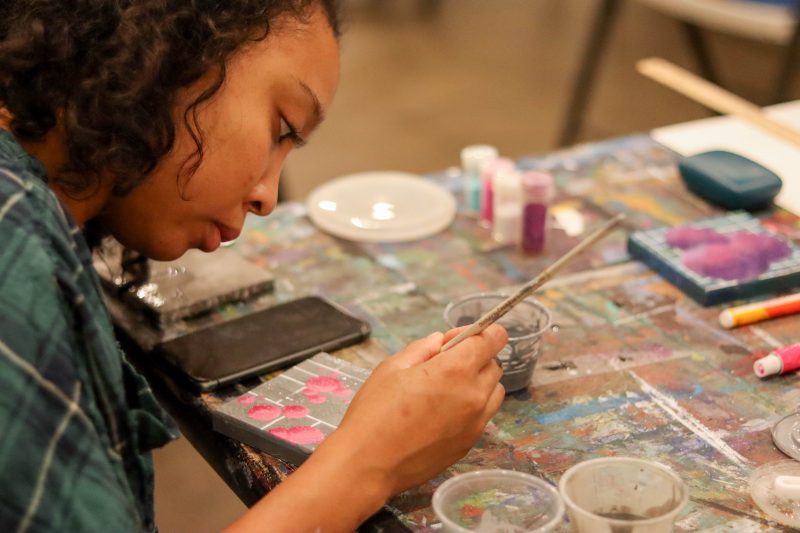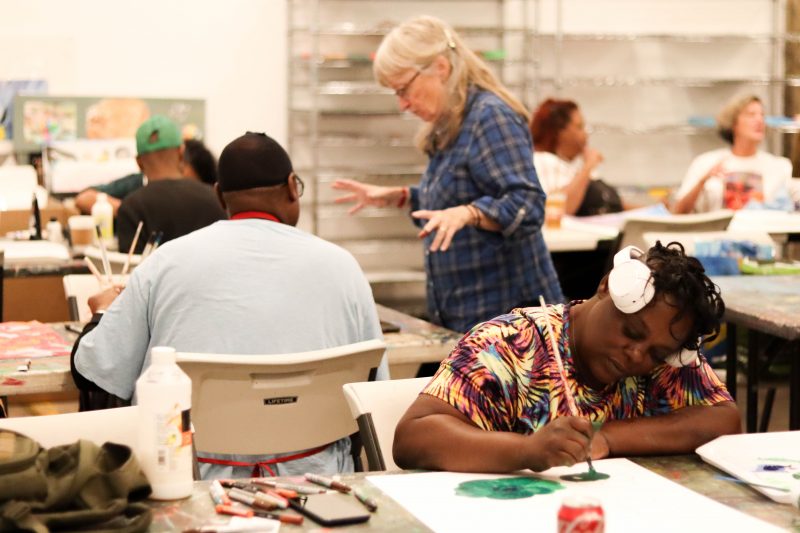Art From the Streets Takes a Creative Approach in Addressing Mental Distress
By Michelle Lavergne
Reporting Texas

A customer looks at one of the thousands of paintings on sale during the 31st Art from the Streets show at the Blue Genie Art Bazaar. The artists received 95% of the proceeds from the sale of their artwork in this event. Michelle Lavergne/Reporting Texas
When Julian Clay first heard about Art From the Streets from a fellow artist staying in the same transitional housing, it took a little bit of convincing before he decided to give it a chance and attend a session.
Ten months later, Clay got to showcase more than 40 pieces of his work during the 31st Art From the Streets art and sale show Oct. 21-22. Many patrons stopped to appreciate his paintings, which are mostly inspired by space.
“I like the beauty of the environment and how calm it looks,” Clay said.

Julian Clay shows off some of his work at the Art from the Streets studio located at the Canopy Austin. Clay started going to the studio at the beginning of the year and created over 40 pieces of art to showcase at the 31st AFTS art and sale show in October. Michelle Lavergne/Reporting Texas
This year’s show came as Art From the Streets achieved two milestones that signify new beginnings for the 32-year-old organization — settling into a permanent home that it moved into in 2021 and an expansion of its mental health programs.
“Art from the Streets is no longer homeless,” AFTS development director Marla Johnson said, adding that having an anchor spot has been meaningful for the group and its artists, who rely on consistency in life.
Its studio is nestled within the confines of Canopy Austin, a multi-business complex in East Austin that has become synonymous with the city’s art community. The collective of galleries open their doors every first Saturday of the month for an “Open Canopy” event where the public can browse art for sale. Johnson said that participating in this has helped elevate the voices of AFTS artists in the professional landscape.
The group has also expanded its outreach program to address the mental health problems that affect its artists, such as conducting art therapy sessions. It started as a pilot program in July thanks to funding from the Texas Commission on the Arts and private donors.
British artist Adrian Hill coined the term “art therapy” in 1942 after he discovered the therapeutic benefits of creating while he recovered from tuberculosis. According to the American Art Therapy Association, this kind of rehabilitation is “particularly effective during times of crisis, changes in circumstance, trauma and grief” since it helps people feel like they have a handle on their lives.
Because homelessness breeds feelings of isolation, Johnson said it can lead to depression and an overwhelming sense of hopelessness.
“The biggest challenge is showing up the first time, feeling that sense of connection and finding yourself through the process of art,” she explained.

Artist Amira Yamaguchi works during a session at the at the Art from the Streets studio. Yamaguchi, who taught herself how to paint, described her artistic style as a symbol of controlled chaos. Michelle Lavergne/Reporting Texas
The AFTS art therapy program consisted of weekly sessions over eight weeks to help artists find ways to develop healthy coping mechanisms. AFTS hopes to continue the program next year.
“Artists come from different walks of life,” said Christina Calderon, who facilitated the art therapy sessions for AFTS. “Art has saved them in so many ways, and I’ve heard it so many times from many artists — that it is more than just art. It is so much bigger than creating.”
Calderon, an accomplished artist herself, is a licensed therapist and counselor who has been weaving art into her sessions with clients since she started her practice almost 10 years ago. She had previously worked with another community art studio in Albuquerque, N.M., as a program coordinator in 2021.
“I was so happy to be able to do this and to create the curriculum they are using,” Calderon said.
Each art therapy session started with the artists sharing how they felt that day and touching base on what happened to them the week before. Calderon then followed up with a prompt to kickstart the artists’ creativity to make something in 20 minutes.
“It was a challenge for them to create art in such a short period of time,” Calderon said. “You are not only processing the act of creation itself, but you’re also sharing your experience. It was harder for them in the beginning because they weren’t used to that format.”
Another struggle the artists had to overcome was beating their inner critics that would come out with every unfinished piece during the sessions.This created feelings of self-doubt among the artists, which Calderon acknowledged was challenging to break down.
But the beauty of engaging in art therapy is that every way is the right way — even when it means the work is not finished.
“This is really about creating something from our feelings and using certain techniques to open ourselves up to possibilities, so there is no finished product,” Calderon said. “That’s why I thought it was so beautiful that some of the artists at the show used some of their work from the sessions. It means a lot to see that they put themselves out there in that way.”
Attending the art therapy sessions has also shown the artists that creating can be more than just a hobby or a way to generate income — they can also use art to regulate their emotions into a mindful practice.
Apart from offering art therapy, AFTS has also been working with community partners who have expertise in mental health like Integral Care, which opened a new community health clinic in North Austin in July. Because of their long working relationship, Integral Care tapped AFTS to create a mural on every floor in its five-story building.
Johnson said that AFTS partnered with professional muralists in the city and paired them with 10 of their artists. The collaboration provided AFTS artists the opportunity to expand their network in an elevated artistic space to set them up for success.
Clay is one of the artists who helped create the murals. As someone who has also struggled with depression, he appreciates being part of projects like this.
“Art from the Streets has shown me that there’s still help and that there are people who still believe in you even when you’re struggling,” Clay said.
Clay is currently working for Capital Metro and rents a room along Sixth Street in downtown Austin. Even if he is no longer unhoused, AFTS is committed to providing care.
“A lot of our artists find housing but they still need purpose and they still need connection,” said Johnson. “It takes so many different services to keep a person stable, connected and happy. Housing isn’t necessarily the only answer.”
As the city of Austin grows, AFTS recognizes that more unhoused people find places to camp further from the city limits. In an effort to continue their outreach, Johnson said their team is looking into setting up satellite operations across Austin to bridge this gap.
“That’s why our volunteers are here,” Johnson said. “It’s why we, on staff, are here. We have this strong desire to build community and to find purpose through that.”

Artists create their paintings as staff and volunteers go around to ask about what they are working on during a session at the Art from the Streets. Michelle Lavergne/Reporting Texas